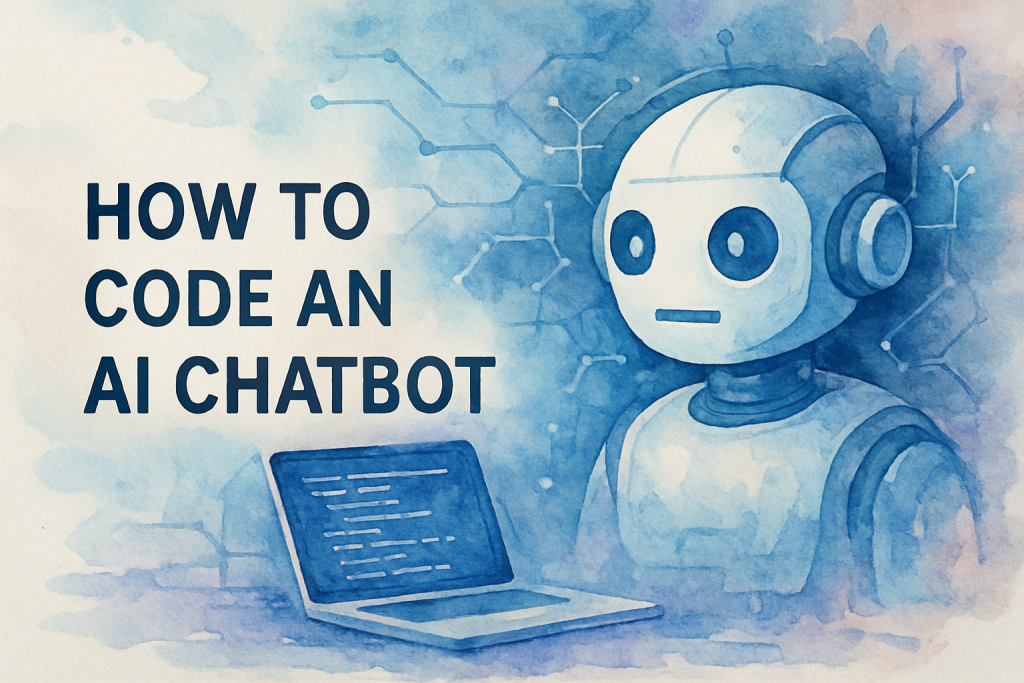How to Code an AI Chatbot: A Step-by-Step Guide 2025 for Business Owners and Marketing Managers
In today’s fast-paced digital landscape, businesses are constantly seeking innovative ways to enhance customer engagement and streamline operations. One such solution that has gained immense popularity is the AI chatbot. But how do you go about coding an AI chatbot that truly meets your business needs? This comprehensive guide will walk you through the process, providing valuable insights for business owners and marketing managers alike.
Whether you’re looking to improve customer service, automate repetitive tasks, or create a unique brand experience, learning how to code an AI chatbot can be a game-changer for your organisation. In this article, we’ll explore the fundamentals of chatbot development, discuss the benefits, and provide a step-by-step implementation guide to help you create your very own AI-powered conversational agent.
Understanding AI Chatbots: The Basics
Before diving into the coding process, it’s essential to grasp the fundamentals of AI chatbots and their significance in today’s business environment.
What is an AI Chatbot?
An AI chatbot is a computer program designed to simulate human conversation through text or voice interactions. Unlike traditional rule-based chatbots, AI-powered chatbots use natural language processing (NLP) and machine learning algorithms to understand and respond to user queries more intelligently and contextually.
The Rise of AI Chatbots in Business
The adoption of AI chatbots has skyrocketed in recent years. According to a report by Grand View Research, the global chatbot market size is expected to reach £1.25 billion by 2025, growing at a CAGR of 24.3% from 2019 to 2025. This surge in popularity is driven by the numerous benefits chatbots offer to businesses across various industries.
Benefits of Implementing AI Chatbots
Understanding the advantages of AI chatbots will help you appreciate the value of learning how to code an AI chatbot for your business. Let’s explore some key benefits:
1. Enhanced Customer Service
- 24/7 availability: AI chatbots can provide round-the-clock support, ensuring your customers receive assistance at any time.
- Instant responses: Chatbots can handle multiple queries simultaneously, reducing wait times and improving customer satisfaction.
- Consistent service: AI-powered chatbots deliver uniform responses, maintaining brand consistency across all interactions.
2. Increased Efficiency and Cost Savings
- Automation of repetitive tasks: Chatbots can handle routine queries, freeing up human agents to focus on more complex issues.
- Reduced operational costs: By automating customer interactions, businesses can significantly reduce staffing expenses.
- Scalability: AI chatbots can easily handle increased volumes of inquiries without the need for additional resources.
3. Improved Lead Generation and Sales
- Personalised recommendations: AI chatbots can analyse user preferences and provide tailored product suggestions.
- Qualifying leads: Chatbots can gather initial information from potential customers, helping to qualify leads more efficiently.
- Seamless purchasing process: By guiding users through the buying journey, chatbots can increase conversion rates and sales.
How to Code an AI Chatbot: A Step-by-Step Guide
Now that we’ve covered the basics and benefits, let’s dive into the process of coding an AI chatbot. Follow these steps to create your own intelligent conversational agent:
1. Define Your Chatbot’s Purpose and Scope
Before you start coding, it’s crucial to clearly define your chatbot’s objectives and limitations:
- Identify the primary goals of your chatbot (e.g., customer support, lead generation, or sales assistance).
- Determine the specific tasks your chatbot will handle.
- Outline the conversation flow and potential user interactions.
2. Choose a Development Platform or Framework
Select a suitable platform or framework for coding your AI chatbot. Some popular options include:
- Dialogflow: Google’s natural language understanding platform
- Microsoft Bot Framework: A comprehensive solution for building and deploying intelligent bots
- Rasa: An open-source machine learning framework for automated text and voice-based conversations
- TensorFlow: Google’s open-source machine learning library
3. Design the Conversational Flow
Map out the conversation flow for your chatbot:
- Create a flowchart or decision tree to visualise user interactions.
- Define intents (user’s intentions) and entities (specific information in user queries).
- Develop a set of predefined responses for common queries.
4. Implement Natural Language Processing (NLP)
Integrate NLP capabilities to enable your chatbot to understand and process human language:
- Use NLP libraries or APIs such as NLTK, spaCy, or Google’s Natural Language API.
- Implement intent recognition to identify user intentions accurately.
- Incorporate entity extraction to capture specific information from user inputs.
5. Develop the Chatbot’s Backend
Build the core functionality of your chatbot:
- Choose a programming language (e.g., Python, JavaScript, or Java).
- Set up a database to store conversation history and user information.
- Implement API integrations for external services or data sources.
6. Train Your AI Model
To improve your chatbot’s performance, train its AI model:
- Gather and prepare training data, including sample conversations and user queries.
- Use machine learning algorithms to train your model on the prepared dataset.
- Continuously refine and update the model based on real-world interactions.
7. Test and Refine Your Chatbot
Thoroughly test your chatbot to ensure optimal performance:
- Conduct extensive user testing to identify and fix any issues.
- Analyse chatbot logs to improve response accuracy and conversation flow.
- Implement A/B testing to optimise user experience and conversion rates.
8. Deploy and Monitor Your Chatbot
Launch your chatbot and monitor its performance:
- Choose a suitable hosting platform for your chatbot (e.g., cloud services or on-premises servers).
- Integrate the chatbot into your website, mobile app, or messaging platforms.
- Set up analytics tools to track key performance metrics and user satisfaction.
Overcoming Common Challenges in AI Chatbot Development
As you embark on your journey to code an AI chatbot, you may encounter several challenges. Here are some common obstacles and solutions:
1. Natural Language Understanding
Challenge: Accurately interpreting user intent and context can be difficult, especially with complex queries or colloquial language.
Solution: Invest time in training your NLP model with diverse datasets and continuously update it based on real-world interactions. Consider implementing sentiment analysis to better understand user emotions and context.
2. Handling Edge Cases
Challenge: Preparing for all possible user inputs and scenarios can be overwhelming.
Solution: Implement fallback mechanisms to handle unexpected queries gracefully. Regularly review chatbot logs to identify and address common edge cases.
3. Maintaining Context
Challenge: Keeping track of conversation context across multiple interactions can be complex.
Solution: Implement a robust dialogue management system that stores and updates conversation history. Use techniques like entity tracking and slot filling to maintain context throughout the conversation.
4. Seamless Human Handoff
Challenge: Determining when to transfer a conversation to a human agent and ensuring a smooth transition can be tricky.
Solution: Implement clear escalation criteria and create a seamless handoff process. Provide human agents with full conversation history to maintain continuity.
Conclusion
Learning how to code an AI chatbot can significantly enhance your business operations and customer experience. By following this comprehensive guide, you’ll be well-equipped to create an intelligent conversational agent that meets your specific needs. Remember that building an effective AI chatbot is an iterative process that requires ongoing refinement and optimization.
As you embark on your chatbot development journey, consider partnering with experts who can guide you through the process and help you maximize the potential of your AI-powered solution. At The Crunch, we specialize in developing cutting-edge AI chatbots tailored to your business requirements.
Frequently Asked Questions (FAQ)
1. What is an AI chatbot?
2. How do I start coding an AI chatbot?
3. What programming languages are best for building AI chatbots?
4. How does an AI chatbot differ from a rule-based chatbot?
5. What are the main benefits of using an AI chatbot?
6. How much does it cost to build an AI chatbot?
7. Do I need to know machine learning to code an AI chatbot?
8. What are some common challenges when coding an AI chatbot?
9. Can I integrate an AI chatbot with my website or app?
10. How do I train my AI chatbot to understand user input?
11. Are there free tools or platforms for building AI chatbots?
12. How can I make my AI chatbot more conversational and human-like?
Ready to take the next step in revolutionizing your customer interactions? Contact The Crunch today to schedule a free consultation and discover how we can help you create a powerful AI chatbot that drives business growth and customer satisfaction.










